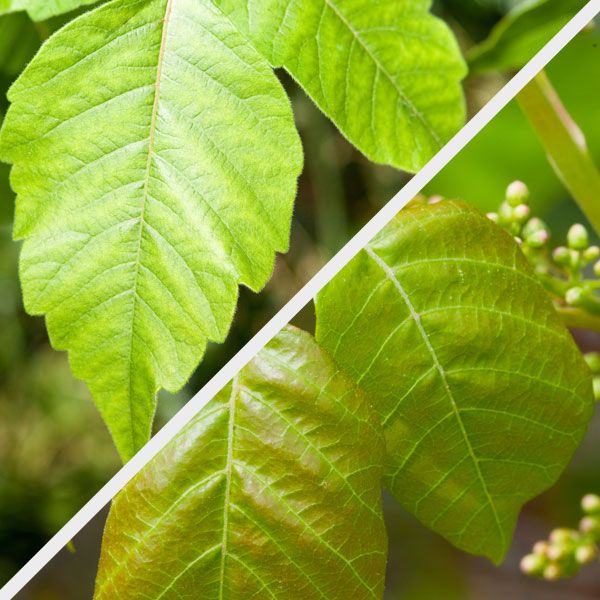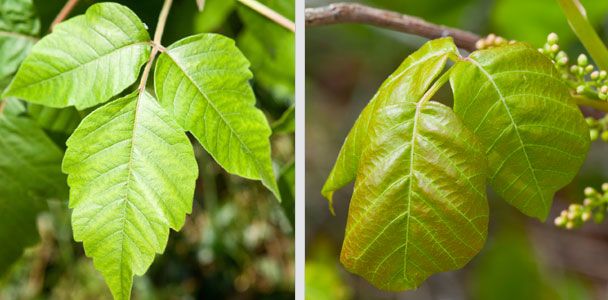
Since there is much folklore about poison ivy, we consulted the experts at the American Academy of Dermatology (AAD), the Food and Drug Administration (FDA), and the Centers for Disease Control and Prevention (CDC) to separate the myths from the facts. Read on for help in identifying poison ivy in your yard and ways to prevent and treat exposure.
Understanding Poison Ivy: An Overview
Poison ivy (Toxicodendron radicans) is a plant found throughout North America—save for Alaska, Hawaii, and some parts of the West Coast—that produces an oily resin called urushiol. This oil is responsible for the allergic reactions many people experience upon contact with the plant.
Urushiol is also found in poison oak and poison sumac. It can penetrate the skin within minutes of contact, and as little as 1 nanogram (1 billionth of a gram) can cause a reaction. The resin is found in the leaves, stems, and roots of poison ivy plant, and it remains active on surfaces for long periods, even on dead plants.
Contrary to popular belief, poison ivy is not actually a type of ivy but belongs to the cashew family. Its ability to cause skin irritation, medically referred to as urushiol-induced contact dermatitis, has made it a well-known and often feared plant among outdoor enthusiasts and gardeners alike.
Identifying Poison Ivy: Beyond “Leaves of Three”
While the old adage “leaves of three, let it be” is a helpful starting point, identifying poison ivy requires more than just counting leaves. Understanding the plant’s various forms and seasonal changes can help you avoid unwanted encounters.
Seasonal Changes in Appearance
Poison ivy’s appearance changes throughout the year, making it important to recognize its various forms:
- Spring: New leaves emerge with a reddish tint and glossy appearance
- Summer: Leaves turn green and may develop a waxy sheen
- Fall: Foliage changes to vibrant shades of red, orange, or yellow
- Winter: The plant loses its leaves, but the vine remains toxic
Regional Variations
Poison ivy can take different forms depending on its location:
- Eastern poison ivy often appears as a hairy, rope-like vine with three leaves budding from one stem.
- Western poison ivy typically grows as a low shrub with three leaves.
- Both varieties can have lobed or smooth leaf edges, depending on the specific plant and environment.
Remember that the shape and number of leaves may vary depending on the species, local environment, and season. Always exercise caution when identifying plants in the wild.
Debunking Common Poison Ivy Myths
Let’s address four widespread misconceptions about poison ivy to help you better understand and deal with this plant.
Myth 1: Poison Ivy Is Getting Stronger
Fact: In June of 2015, a CBS News report publicized research suggesting that poison ivy might be growing larger and producing more potent urushiol due to increased carbon dioxide levels in the atmosphere. However, more evidence is needed to support this claim conclusively, and there appears to have been little research in the intervening years to follow up on it.
What we do know is that about 85% of people are sensitive to urushiol and will develop a rash upon exposure, making it one of the world’s most common allergens. The remaining 15% of people may never experience a reaction.
Additionally, a person’s sensitivity to poison ivy can change over time. The AAD points out that while a rash may not occur after a person’s first exposure, subsequent exposures are likely to result in a reaction for those who are sensitive. Thus, it may not be the plant itself producing stronger reactions but rather people who are sensitive to the plant noticing stronger and faster reactions over time.
Myth 2: Only Direct Contact Causes a Rash
Fact: Direct contact with the plant is not the only way to develop a poison ivy rash. An allergic reaction can occur through indirect contact with urushiol oil on various surfaces, including:
- Garden tools
- Pet fur
- Clothing
- Shoes
Urushiol oil can remain active on surfaces for up to five years, making indirect exposure a significant risk. To protect yourself, always wear long sleeves, pants, boots, and non-permeable gloves when working in areas where poison ivy may be present. Wash exposed clothing separately and clean tools with rubbing alcohol or soap and water after use.
Also, while it doesn’t cause a rash, the CDC warns that burning poison ivy, as well as poison oak or sumac, creates smoke that can irritate the lungs and eyes. Thus, you should never attempt to dispose of these plants by burning them. Read our expert’s advice on how to clear poison ivy from your yard safely instead.
Myth 3: The Rash Is Contagious
Fact: Contrary to popular belief, the FDA points out that poison ivy rashes are not contagious. The fluid in the blisters does not contain urushiol oil, so you cannot spread the rash to other parts of your body or to other people through skin-to-skin contact or by touching the blisters. However, if urushiol oil remains on your skin or clothing, it can cause new rashes upon contact.
To prevent spreading the oil, the AAD recommends washing the affected skin thoroughly with soap and lukewarm water as soon as possible after exposure. There are specialty soaps and towelettes, but mild dishwashing soap, laundry detergent, or rubbing alcohol will also work. Thoroughly rinse, and then wash under your nails to remove any remaining oil. When you’re finished, do your best to avoid scratching the rash, as this can lead to infection.
Myth 4: Everyone Reacts the Same Way
Fact: Reactions to poison ivy can vary significantly from person to person. Some people may experience only mild itching and redness, while others may develop severe blistering and swelling. While most people (about 85%) are sensitive to urushiol, the severity of the reaction can differ based on factors such as:
- Individual sensitivity
- Amount of exposure
- Location of contact on the body (e.g., palms and soles of feet are less sensitive, underarms are more sensitive)
- Previous exposures
As we’ve noted, it’s also possible for a person’s sensitivity to change over time, potentially becoming more severe with repeated exposures. The time frame of an allergic reaction can also change. A person’s first contact with poison ivy may take 10–21 days to develop a rash, whereas it may only take 48–72 hours after multiple encounters.
Poison Ivy Prevention and Protection Strategies
Taking proactive steps to prevent poison ivy exposure is the best way to avoid uncomfortable rashes and potential complications.
Proper Clothing and Equipment
When venturing into areas where poison ivy may be present:
- Wear long sleeves, long pants, and closed-toe shoes.
- Use non-permeable gloves when gardening or working outdoors
- Keep gloves on while removing your work clothes.
- Consider using barrier creams designed to protect against urushiol.
Recognizing High-Risk Areas
Poison ivy thrives in various environments:
- Wooded areas and forest edges
- Fields and meadows
- Along fences and walls
- In landscaped areas and gardens
Learn to identify poison ivy in its various forms and be extra cautious in these high-risk areas.
Poison Ivy Treatment Options for Poison Ivy Exposure
If you do come into contact with poison ivy, the AAD recommends prompt action to help minimize the reaction and provide relief.
Home Remedies
For mild to moderate reactions:
- Wash the affected area thoroughly with lukewarm water and soap.
- Apply cool compresses to reduce itching and inflammation.
- Use over-the-counter calamine lotion or hydrocortisone (corticosteroid) cream.
- Try oatmeal baths to soothe irritated skin.
- Take oral antihistamines to reduce itching.
However, you should not apply antihistamines (like Benadryl cream) directly to your skin, which may make the rash and the itch worse.
When To Seek Medical Attention
Consult a healthcare professional if:
- The rash covers a large portion of your body.
- You think the rash may be infected.
- You develop a fever or have difficulty breathing.
- The rash affects sensitive areas like your face or genitals.
- Symptoms persist or worsen after a week of home treatment.
- You have a known severe allergy to poison ivy.
In these cases, a doctor may prescribe oral corticosteroids or other treatments to manage severe reactions.
Safe Removal of Poison Ivy from Your Property
If you discover poison ivy on your property, it’s important to remove it safely to prevent exposure and spread.
DIY Removal Techniques
For small areas of poison ivy:
- Wear protective clothing, including long sleeves, pants, and gloves.
- Pull plants from the roots, bagging them as you go.
- Dispose of bagged plants in the trash, not in compost or by burning.
- Clean all tools and clothing thoroughly after removal.
There are also poison ivy-specific herbicides, but keep in mind that you may need to apply multiple treatments and the plants can still cause allergic reactions even after they’re dead.
Professional Removal Services
For large infestations or if you’re highly sensitive to poison ivy, consider hiring a professional removal service. These experts have the proper equipment and experience to safely eliminate poison ivy from your property without risking exposure.
Our Conclusion
Understanding the facts about poison ivy is vital for anyone who spends time outdoors. By dispelling common myths and arming yourself with accurate information, you can better protect yourself and others from uncomfortable reactions. Remember that prevention is key—learn to identify poison ivy, take proper precautions, and seek prompt treatment if exposure occurs.

